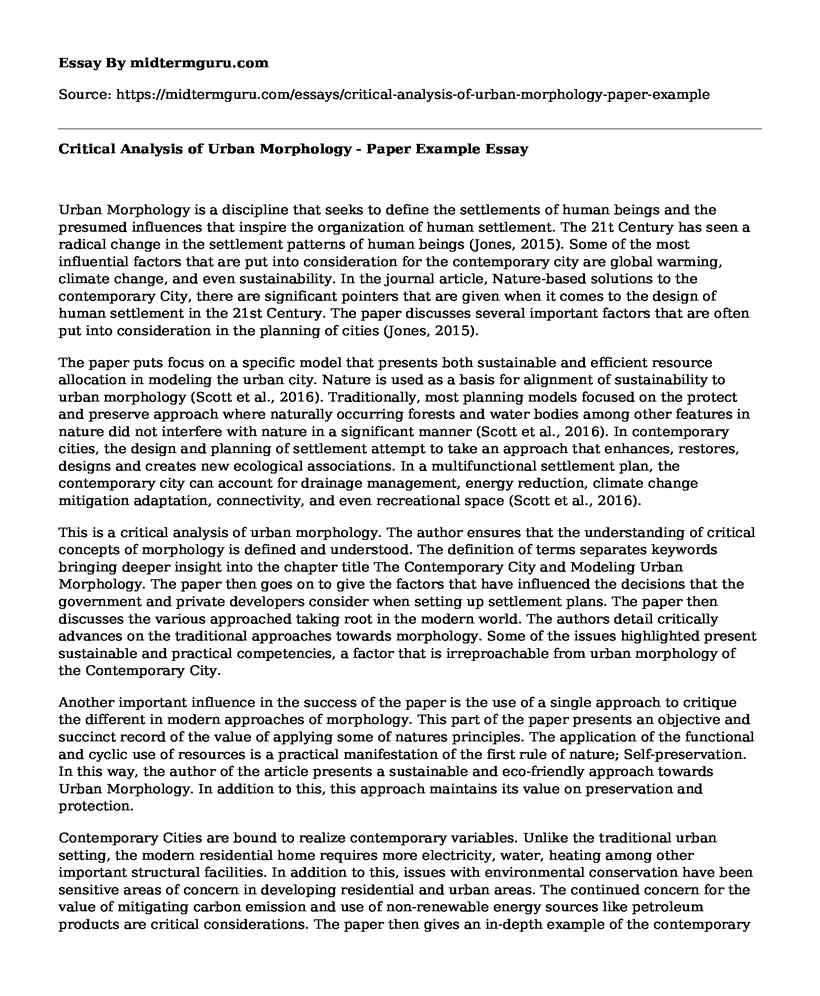Urban Morphology is a discipline that seeks to define the settlements of human beings and the presumed influences that inspire the organization of human settlement. The 21t Century has seen a radical change in the settlement patterns of human beings (Jones, 2015). Some of the most influential factors that are put into consideration for the contemporary city are global warming, climate change, and even sustainability. In the journal article, Nature-based solutions to the contemporary City, there are significant pointers that are given when it comes to the design of human settlement in the 21st Century. The paper discusses several important factors that are often put into consideration in the planning of cities (Jones, 2015).
The paper puts focus on a specific model that presents both sustainable and efficient resource allocation in modeling the urban city. Nature is used as a basis for alignment of sustainability to urban morphology (Scott et al., 2016). Traditionally, most planning models focused on the protect and preserve approach where naturally occurring forests and water bodies among other features in nature did not interfere with nature in a significant manner (Scott et al., 2016). In contemporary cities, the design and planning of settlement attempt to take an approach that enhances, restores, designs and creates new ecological associations. In a multifunctional settlement plan, the contemporary city can account for drainage management, energy reduction, climate change mitigation adaptation, connectivity, and even recreational space (Scott et al., 2016).
This is a critical analysis of urban morphology. The author ensures that the understanding of critical concepts of morphology is defined and understood. The definition of terms separates keywords bringing deeper insight into the chapter title The Contemporary City and Modeling Urban Morphology. The paper then goes on to give the factors that have influenced the decisions that the government and private developers consider when setting up settlement plans. The paper then discusses the various approached taking root in the modern world. The authors detail critically advances on the traditional approaches towards morphology. Some of the issues highlighted present sustainable and practical competencies, a factor that is irreproachable from urban morphology of the Contemporary City.
Another important influence in the success of the paper is the use of a single approach to critique the different in modern approaches of morphology. This part of the paper presents an objective and succinct record of the value of applying some of natures principles. The application of the functional and cyclic use of resources is a practical manifestation of the first rule of nature; Self-preservation. In this way, the author of the article presents a sustainable and eco-friendly approach towards Urban Morphology. In addition to this, this approach maintains its value on preservation and protection.
Contemporary Cities are bound to realize contemporary variables. Unlike the traditional urban setting, the modern residential home requires more electricity, water, heating among other important structural facilities. In addition to this, issues with environmental conservation have been sensitive areas of concern in developing residential and urban areas. The continued concern for the value of mitigating carbon emission and use of non-renewable energy sources like petroleum products are critical considerations. The paper then gives an in-depth example of the contemporary city, citing drainage management, ecological connectivity and the design of a city-wide ecological network. This analysis gives perspective on the chapter title.
References
Jones, P. (2015). Modelling urban futures. City, 19(4), 463-479. http://dx.doi.org/10.1080/13604813.2015.1051729
Scott, M., Lennon, M., Haase, D., Kazmierczak, A., Clabby, G., & Beatley, T. (2016). Nature-based solutions for the contemporary city/Re-naturing the city/Reflections on urban landscapes, ecosystems services and nature-based solutions in cities/Multifunctional green infrastructure and climate change adaptation: brownfield greening as an adaptation strategy for vulnerable communities?/Delivering green infrastructure through planning: insights from practice in Fingal, Ireland/Planning for biophilic cities: from theory to practice. Planning Theory & Practice, 17(2), 267-300. http://dx.doi.org/10.1080/14649357.2016.1158907
Cite this page
Critical Analysis of Urban Morphology - Paper Example. (2021, Jun 03). Retrieved from https://midtermguru.com/essays/critical-analysis-of-urban-morphology-paper-example
If you are the original author of this essay and no longer wish to have it published on the midtermguru.com website, please click below to request its removal:
- The Disability Matrix in Schools
- Reflection on Childrens Ministries
- Essay Sample on Globalization of the English Language
- Essay on Introducing the Logic Model
- Essay on Online vs Traditional Classes
- Raising Gifted and Talented Children: Challenges and Strategies - Essay Sample
- Essay Sample on Sequence and Rates of Development







